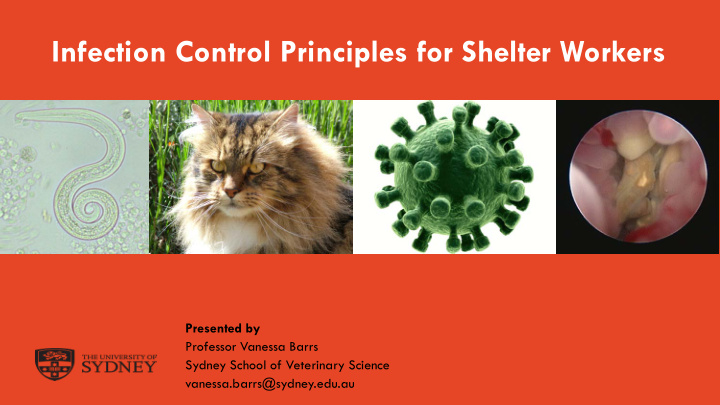



Infection Control Principles for Shelter Workers Presented by Professor Vanessa Barrs Sydney School of Veterinary Science vanessa.barrs@sydney.edu.au The University of Sydney Page 1
Feline infectious diseases in shelters Cat flu (viruses + bacteria) • Feline parvovirus • Feline infectious peritonitis (FIP) • Feline leukaemia virus (FeLV) • Feline immunodeficiency virus (FIV) • Parasites (worms, protozoa, fleas) • Ringworm (fungal) • The University of Sydney Page 2
How feline infections are spread Direct contact • - biting - scratching - grooming - mating The University of Sydney Page 3
How infections are spread Indirect contact • - with secretions from an infected cat faeces, urine, snot, eye goop, vomit - with fomites The University of Sydney Page 4
How infections are spread By vectors • - mechanical spread - biting The University of Sydney Page 5
Signs of cat flu Depressed Not eating Nasal discharge Sneezing Conjunctivitis Blinking or squinting Mouth ulcers
Cat flu Feline Calicivirus Feline Calicivirus (FCV) The University of Sydney Page 7
Feline Herpes Virus (FHV) Cat flu FCV, FHV, bacteria The University of Sydney Page 8 Images courtesy Dr. Christine Heinrich
Transmission of flu viruses • Highly contagious FCV - survives for a month in environment • Spread in snot and eye secretions • Spread by you!!!! (fomites) • Sneezed droplets travel at least 1 metre • The University of Sydney Page 9
Feline parvovirus (FPV) lethargy loss of appetite • Highly contagious vomiting Survives > 1 year in environment • diarrhoea Spread in all body fluids • dehydration Spread by you!!!! (fomites) • death The University of Sydney Page 10
Hand washing or hand sanitizing? • Always wash if there visible soiling • Washing removes organic matter that traps viruses
Liquid soap for hand-washing • Accelerated hydrogen peroxide • Removes dirt, organic matter • Antibacterial, antiviral • Use in isolation and quarantine wards The University of Sydney Page 12
When can I use hand-sanitizer? • Only if there is no visible soiling
Wash thoroughly Dry thoroughly • Remove your jewellery first ! • At least 15s The University of Sydney Page 14
Which hand-sanitizer? • Use alcohol-based (70-90% v/v) • Use products containing emollients to prevent cracked skin
Do alcohol hand-sanitizers kill cat viruses & ringworm? Mostly NOT • Cat flu (FCV), parvoviruses and ringworm are resistant The University of Sydney Page 16
When to hand wash/sanitize – Before and after work – Before wearing disposable gloves – Before and after processing new animals – After handling sick animals – Before eating, drinking, smoking – Before and after using phones, computers – After handling waste – After going to the toilet – At anytime your hands are visibly soiled or feel sticky/grimy – After cleaning tasks – After handling dirty laundry – cat bedding/scrub wear The University of Sydney Page 17
Personal Protective Equipment Disposable PPE Washable PPE Wear clean scrubs every day Change after doing dirty tasks Change after handling sick animals The University of Sydney Page 18
When should I change my gloves? • Between every cage • Sanitise hands after you remove gloves
Animal excretions Disinfectants • Inactivate disinfectants • Clean with detergent first QAC/ Biguanide Combinations F10 disinfectant Trigene II FPV: 1:100 (contact time15 mins) FPV: 1:50 (contact time15 mins) Not effective against FCV Not effective against FCV Effective against ringworm Effective against ringworm
Disinfectants Effective against: Effective against: FCV FCV • • FHV FHV • • FPV FPV • • Ringworm 2% solution, 10 min • • contact time effective against ringworm. Potassium peroxymonosulfate (contact time 10 mins) Sodium hypochlorite 1:30 dilution of a 5-6% solution (contact time 15 min)
Disinfectants AHP Accelerated hydrogen peroxide Effective against: FCV • FHV • FPV • Ringworm • The University of Sydney Page 22
Recommend
More recommend